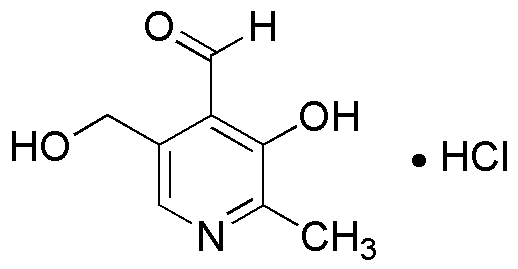Pyridoxal hydrochloride is widely utilized in research focused on:
- Vitamin B6 Supplementation: It serves as a vital source of vitamin B6, essential for various metabolic processes, making it popular in dietary supplements aimed at improving overall health.
- Pharmaceutical Applications: This compound is used in the formulation of medications for treating conditions related to vitamin B6 deficiency, such as anemia and peripheral neuropathy.
- Biochemical Research: Researchers utilize pyridoxal hydrochloride in enzyme assays and studies involving amino acid metabolism, helping to uncover mechanisms of action in biological systems.
- Food Industry: It is added to food products as a fortifying agent to enhance nutritional value, particularly in cereals and health foods, addressing dietary deficiencies.
- Cosmetic Formulations: The compound is incorporated into skincare products for its potential benefits in improving skin health, promoting a more radiant complexion.
General Information
Properties
Safety and Regulations
Applications
Pyridoxal hydrochloride is widely utilized in research focused on:
- Vitamin B6 Supplementation: It serves as a vital source of vitamin B6, essential for various metabolic processes, making it popular in dietary supplements aimed at improving overall health.
- Pharmaceutical Applications: This compound is used in the formulation of medications for treating conditions related to vitamin B6 deficiency, such as anemia and peripheral neuropathy.
- Biochemical Research: Researchers utilize pyridoxal hydrochloride in enzyme assays and studies involving amino acid metabolism, helping to uncover mechanisms of action in biological systems.
- Food Industry: It is added to food products as a fortifying agent to enhance nutritional value, particularly in cereals and health foods, addressing dietary deficiencies.
- Cosmetic Formulations: The compound is incorporated into skincare products for its potential benefits in improving skin health, promoting a more radiant complexion.
Documents
Safety Data Sheets (SDS)
The SDS provides comprehensive safety information on handling, storage, and disposal of the product.
Product Specification (PS)
The PS provides a comprehensive breakdown of the product’s properties, including chemical composition, physical state, purity, and storage requirements. It also details acceptable quality ranges and the product's intended applications.
Certificates of Analysis (COA)
Search for Certificates of Analysis (COA) by entering the products Lot Number. Lot and Batch Numbers can be found on a product’s label following the words ‘Lot’ or ‘Batch’.
*Catalog Number
*Lot Number
Certificates Of Origin (COO)
This COO confirms the country where the product was manufactured, and also details the materials and components used in it and whether it is derived from natural, synthetic, or other specific sources. This certificate may be required for customs, trade, and regulatory compliance.
*Catalog Number
*Lot Number
Safety Data Sheets (SDS)
The SDS provides comprehensive safety information on handling, storage, and disposal of the product.
DownloadProduct Specification (PS)
The PS provides a comprehensive breakdown of the product’s properties, including chemical composition, physical state, purity, and storage requirements. It also details acceptable quality ranges and the product's intended applications.
DownloadCertificates of Analysis (COA)
Search for Certificates of Analysis (COA) by entering the products Lot Number. Lot and Batch Numbers can be found on a product’s label following the words ‘Lot’ or ‘Batch’.
*Catalog Number
*Lot Number
Certificates Of Origin (COO)
This COO confirms the country where the product was manufactured, and also details the materials and components used in it and whether it is derived from natural, synthetic, or other specific sources. This certificate may be required for customs, trade, and regulatory compliance.


